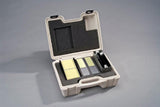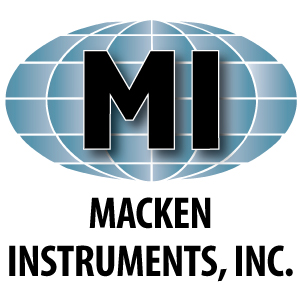Near IR Image Plates
- CW YAG, Pulsed Nd, GaAs
- 200 watts continuous
- 0.7-1.3µ Response
 The IR Display Plate is a versatile instrument that presents clear, high contrast images of all near IR laser beams. These displays are made on infrared sensitive phosphors which offer a variety of unique features, variable image retention times for pulsed lasers, high resolution for CW YAG, and a good response to gallium arsenide light-emitting diodes. All near IR lasers are capable of being displayed over a wide sensitivity range.
The IR Display Plate is a versatile instrument that presents clear, high contrast images of all near IR laser beams. These displays are made on infrared sensitive phosphors which offer a variety of unique features, variable image retention times for pulsed lasers, high resolution for CW YAG, and a good response to gallium arsenide light-emitting diodes. All near IR lasers are capable of being displayed over a wide sensitivity range.
Surfaces
Macken Instruments' Model 24 makes use of three different types of IR-sensitive surfaces to cover the varied near IR laser display requirements.
Surface #1 is primarily designed for use with YAG Lasers. When illuminated by an ultraviolet lamp, this surface fluoresces a bright yellow. Striking the fluorescing surface with near IR light induces a transition which results in a quenching of the fluorescence. Therefore, the IR beam is displayed as a dark image on a bright fluorescent background.
The sensitivity of this surface can be varied over a wide range by changing the intensity of the UV illumination; i.e, the distance of the UV lamp from the surface. The response time also depends on the UV illumination but is typically less than 10 milliseconds. This fast a response time is well suited for viewing rapidly changing YAG mode patterns; however, such a recovery time is too rapid to view a single pulsed laser.
Surface #2 is designed to be used with pulsed neodymium and other pulsed IR lasers. This surface fluoresces a bright green. Like surface #1, IR quenching produces a dark image display on a bright background. However, this surface has a much longer decay time which is ideally suited for viewing pulsed lasers.
Depending on the illumination conditions, the image retention time can be varied from one tenth of a second to several minutes. The more intense the UV illumination, the shorter the persistence. When no UV illumination is used, and when the background illumination is dimmed, the phosphorescence of the surface will retain the laser beam pattern for several minutes.
Surface #3 is used primarily for viewing gallium arsenide light-emitting diodes and for probing CW YAG laser beams. This surface operates on a different principle than
Near IR radiation stimulates the release of this energy as yellow-orange light. Consequently, the beam appears as a bright image on a dark background. After the phosphors have absorbed a given amount of IR energy, the surface can become depleted. The beam must then be moved to a new area of the surface or the surfaced recharged.
All plate and imaging surfaces have a matte finish for safe beam displays.
